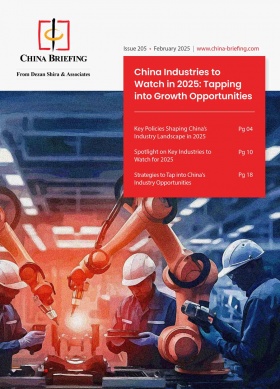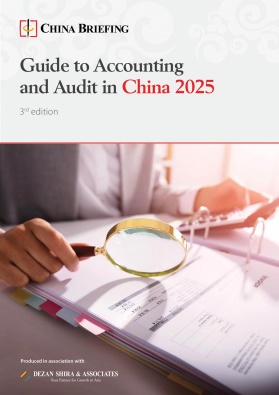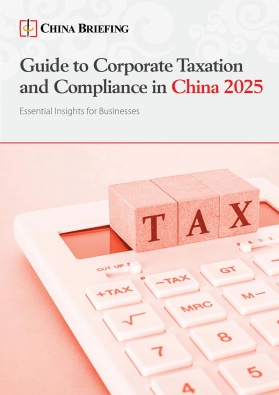China’s Two Sessions 2025: Key Takeaways from the Government Work Report
China’s Premier Li Qiang delivered the highly anticipated 2025 Government Work Report at the opening of the Two Sessions, presenting a detailed policy roadmap for the year ahead. For foreign investors and stakeholders, this report not only outlines China’s economic priorities but also highlights key regulatory and market conditions that may impact investment decisions.
The Two Sessions, or Lianghui, is the popular name for the back-to-back meetings of two of China’s major political bodies – the Chinese People’s Political Consultative Conference (CPPCC) and the National People’s Congress (NPC), China’s legislature. The Two Sessions are closely watched by foreign investors, as they provide a key insight into China’s political landscape, reveal Beijing’s priorities for the coming year, and outline the country’s overall policy direction.
On Wednesday, March 5, 2025, the NPC convened for its opening meeting of the annual Two Sessions. In the meeting, Premier Li Qiang delivered the 2025 Government Work Report (2025 GWR) on behalf of the State Council, which sets a vast range of economic and development tasks for the country to pursue over the coming year. It includes the 2025 GDP growth target and outlines how China plans to achieve its economic goals.
In this article, we examine the highlights of China’s 2025 GWR, including the 5 percent GDP growth target and industry priorities, as well as measures to boost consumption, attract foreign investment, maneuver China’s green transition, and mitigate financial risks.
China’s economic performance in 2024 and key 2025 targets
The 2025 GWR celebrates the stable growth of the economy in 2024, exemplified by the 5 percent year-on-year GDP growth rate and stable levels of inflation and unemployment.
China’s Economy in 2024
GDP: RMB 134.9 trillion (US$19 trillion), +5%
New urban jobs: 12.56 million
Surveyed urban unemployment rate: 5.1%
Consumer Price Index (CPI): +0.2%
Foreign exchange reserves: Over US$3.2 trillion
Disposable income per capita: +5.1%
The report also highlights advancements in production and industrial upgrades, including record grain output and stronger yields, significant growth in the added value of high-tech industries, and major innovations in integrated circuits, artificial intelligence, and quantum technology.
Production and Industry in 2024
Grain production output: Over 840 million metric tons
Electric vehicle production: Over 13 million
High-tech manufacturing added value: +8.9%
Equipment manufacturing added value: +7.7%
Energy consumption per unit of GDP: -3%
Transmission software and IT services added value: +10.9%
Leasing and business services added value: +10.4%
Renewable energy installed capacity: + 370 million kilowatts.
Key 2025 growth and development targets
The headline target for 2025 is achieving GDP growth of “around 5 percent”. However, the government has also set a range of other quantitative goals, including the creation of new jobs, inflation, grain production, and energy consumption.
According to the 2025 GWR, the proposed targets consider both domestic and international conditions and seek to strike a balance between necessity and feasibility. The 5 percent GDP growth target seeks to support employment, risk prevention, and public well-being while aligning with long-term development goals. Meanwhile, the urban surveyed unemployment rate is set at approximately 5.5 percent, reflecting efforts to stabilize employment amid structural challenges. Consumer price inflation is targeted at around 2 percent, aiming to maintain price stability through policy and reform measures. Achieving these goals will be challenging and require significant effort.
Key Growth and Development Targets for 2025
GDP: Around 5%
Surveyed urban unemployment rate: Around 5.5%
New urban jobs: Over 12 million
CPI: Around 2%
Grain production output: Around 840 million metric tons
Energy consumption per unit of GDP: Reduce by around 3%
Policy directions for economic and social development in 2025
The 2025 GWR outlines a comprehensive strategic vision for economic and social development. 2025 marks the final year of the 14th Five-Year Plan, and the government thus emphasizes a balanced approach—”maintaining stability while achieving progress”—by fully implementing new development concepts, accelerating the establishment of a new development pattern, and pursuing high-quality growth.
This approach seeks to deepen reforms, expand high-level opening, and build a modern industrial system, while also ensuring that development and security are managed in tandem. In doing so, policymakers aim to stimulate domestic demand, drive the integration of technological and industrial innovation, stabilize the real estate and stock markets, and manage both key risks and external shocks, all with the goal of sustaining economic recovery and improving people’s living standards. It also aims to lay a solid foundation for the start of the 15th Five-Year Plan.
More proactive fiscal policies
On the fiscal front, the government has committed to a more proactive approach. The report details plans to increase the fiscal deficit to around 4 percent, with an expanded deficit scale and boosted public expenditure. This includes issuing special bonds and local government debt earmarked for infrastructure development, land acquisition, and other critical projects. Efforts are also underway to optimize spending structures, prioritize measures that enhance social welfare and consumption, and ensure that fiscal resources are allocated efficiently. By reinforcing central fiscal transfers and tightening fiscal discipline, the government intends to maintain robust support for economic and social initiatives while curbing wasteful expenditures.
China’s 2025 Fiscal and Debt Issuance Targets
- Deficit ratio: Around 4%, up 1 percentage point from 2024.
- Deficit scale: RMB 5.66 trillion (US$776 billion), up by RMB 1.6 trillion (US$219 billion) from 2024.
- General public budget expenditure: Set at RMB 29.7 trillion (US$4.07 trillion), an increase of RMB 1.2 trillion (US$164 billion) from 2024.
- Ultra-long-term special government bonds: Planned issuance worth RMB 1.3 trillion (US$178 billion), an increase of RMB 300 billion (US$41 billion) from 2024.
- Special government bonds: Planned issuance worth RMB 500 billion (US$68 billion) to support capital replenishment for large state-owned commercial banks.
- Local government special-purpose bonds: Planned at RMB 4.4 trillion (US$603 billion), an increase of RMB 500 billion (US$68 billion) from 2024.
- Total new government debt: Projected at RMB 11.86 trillion (US$1.62 trillion), an increase of RMB 2.9 trillion (US$397 billion) from 2024.
Moderately accommodative monetary policies
Monetary policy is set to be appropriately accommodative, with a dual focus on maintaining liquidity and adjusting both quantitative and structural measures. The report indicates that policymakers will use tools such as reserve requirement adjustments and interest rate cuts to ensure that the growth of social financing and the money supply align with economic and price stability targets. Innovations in structural monetary policy will further support healthy development in key sectors like real estate, technology, green industries, consumption, and small and micro enterprises. These measures are designed to lower financing costs and enhance the availability of financial services, thereby contributing to a more stable and dynamic economic environment.
More concerted policy implementation
This approach involves a “policy combination” that synchronizes fiscal, monetary, employment, industrial, regional, trade, environmental, and regulatory strategies. The goal is to ensure timely and effective policy implementation—from the initial stages to the final impact—by closely coordinating across all levels of government and sectors of the economy. Through this integrated policy effort, the government aims to shape positive market expectations and lay a solid foundation for the next phase of economic development under the 15th Five-Year Plan.
China’s key development tasks for 2025
In addition to the specific targets above, the 2025 GWR outlines 10 key tasks for 2025. These tasks focus on priority economic areas and development goals, and include measures for boosting consumption, modernizing industries, attracting foreign investment, and promoting green development and transition, among others.
“This year’s economic and social development tasks are very heavy. We must highlight the priorities, grasp the critical points, and focus our energy on the following aspects.”
— 2025 Government Work Report
The 10 key tasks are:
- Boosting consumption: Implement special actions to boost consumption, improve investment efficiency, and expand domestic demand.
- Developing and upgrading industry: Cultivate and expand emerging and future industries, promote the transformation and upgrading of traditional industries, and stimulate the innovation vitality of the digital economy.
- Developing science and innovation: Accelerate the construction of a high-quality education system, promote high-level scientific and technological self-reliance, and comprehensively enhance talent.
- Promote implementation of landmark reform measures: Effectively stimulate the vitality of various business entities, deepen the construction of a unified national market, and deepen the reform of the fiscal, tax and financial systems.
- Expand high-level opening up: Stabilize foreign trade development, encourage foreign investment, promote the “Belt and Road” Initiative, and deepen multilateral, bilateral, and regional economic cooperation.
- Prevent and resolve risks in key areas: Continue efforts to stabilize the real estate market, resolve local government debt risks, and actively prevent risks in the financial sector.
- Promote rural revitalization: Ensure stable production and supply of important agricultural products such as grain, consolidate and expand achievements in poverty alleviation, and promote rural reform and development.
- Promote new urbanization and regional coordinated development: Implement the new urbanization strategy action and increase the implementation of regional strategies.
- Promote carbon reduction, pollution control, green expansion, and growth: Strengthen pollution prevention and control and ecological construction, accelerate the development of a green and low-carbon economy, and actively and steadily promote peak carbon emissions and carbon neutrality.
- Ensuring and improving people’s livelihoods while enhancing social governance efficiency: Stabilize and expand employment, strengthen basic medical and health services, improve social security and service policies, strengthen the construction of spiritual civilization, and maintain national security and social stability.
Boosting consumption and domestic demand
The first key task in the 2025 government work report focuses on boosting consumption, enhancing investment efficiency, and expanding domestic demand. The goal is to make domestic demand the primary driver of economic growth by addressing consumption weaknesses and integrating consumption with investment.
The 2025 GWR highlights several key measures to improve consumer purchasing power, increase high-quality supply, and enhance the consumer environment. These include improving the buying power of low-income residents by boosting income growth and reducing burdens for low- and middle-income groups while improving the normal wage growth mechanism for workers.
In addition, the 2025 GWR states that the government will allocate RMB 300 billion (US$41.3 billion) in special ultra-long-term bonds for trade-in schemes. Efforts will also be made to boost services consumption, in particular healthcare, elderly care, childcare, and domestic services, by improving access, reducing restrictions, and optimizing supervision of these fields. It also seeks to develop new consumption in areas such as digital, green, and smart products and services, while optimizing holidays to boost spending on culture, tourism, and sports.
Meanwhile, the 2025 GWR aims to stimulate consumption by expanding effective investment. The central budget has earmarked RMB 735 billion (US$101.2 billion) for investment in 2025. Additionally, the government plans to enhance the management of local government special-purpose bonds (SPBs) and implement a negative list for investment areas to streamline project approvals. The 2025 GWR also emphasizes increasing investment in the service sector and attracting more private capital by refining public-private partnership mechanisms, creating greater opportunities for private investment in infrastructure and public services.
Developing new quality productive forces and promoting industrial upgrading
The 2025 GWR summarizes key tasks for industrial development, focusing on the development of new quality productive forces (NQPFs), upgrading traditional sectors, and growing the digital economy.
First introduced in late 2023, NQPFs has become a key concept within China’s industrial policy. The term NQPFs refers to an innovation-driven growth model where emerging technologies create new industries, economic models, and social structures. They also help transform and modernize traditional industries through digitization, connectivity, and smart upgrades.
To cultivate and expand these emerging and future industries, the government will seek to advance the integration of strategic emerging industries by consolidating key capabilities in industry clusters. Additionally, it will promote the integration of advanced manufacturing and modern services, accelerate service-oriented manufacturing, and strengthen industrial planning, capacity monitoring, and competition. Innovation in national high-tech zones will be accelerated, and more support will be given to growing SMEs, unicorns, and fast-growing gazelle companies in emerging sectors.
To promote the upgrading of traditional industries, the 2025 GWR stresses the importance of modernizing manufacturing equipment and processes. Key measures proposed include implementing large-scale equipment renewal projects and accelerating digitization by cultivating service providers with expertise in both industry and digitization. It also calls for providing more support to SMEs to undergo digital transformation.
Finally, the 2025 GWR highlights the need to develop the digital economy. It outlines initiatives such as “AI+ action” (employing AI to boost efficiency in the real economy), and calls for better combining digital technology with manufacturing and markets, supporting the wide use of large AI models, and developing smart devices such as connected electric vehicles, AI phones and computers, robots, and smart manufacturing equipment.
It also outlines the need to expand 5G use, accelerate the growth of the industrial internet, improve the national computing power system, and improve the data system, by making better use of data and improving cross-border data transfer regulations.
Promoting urbanization and rural revitalization
Urbanization and rural revitalization are two of the government’s core strategies for alleviating poverty and boosting the incomes and livelihoods of Chinese citizens. The 2025 GWR calls for implementing the “new urbanization strategy action”, which will see the gradual integration of rural populations into cities, continued urban renewal, and the renovation of old residential areas.
Efforts will also focus on optimizing land use, improving flood control systems, and enhancing infrastructure like gas, water, heating, and underground utilities. Additionally, the plan emphasizes developing digital and smart infrastructure, improving accessibility for elderly people, and upgrading community services to create livable, resilient, and smart cities. At the same time, the 2025 GWR aims to boost rural revitalization by prioritizing agriculture and rural development.
It focuses on increasing agricultural efficiency, revitalizing rural areas, and improving farmers’ incomes. The government will ensure the consolidation of poverty alleviation gains, enhance monitoring and support, and prevent large-scale poverty and regression.
The 2025 GWR also emphasizes rural reforms, including improving the rural land management system, extending land contracts for farmers, and enhancing agricultural services. The report also aims to foster the growth of new rural collective economies and calls for creating investment and financing mechanisms for rural revitalization. To encourage sustainable growth, it also calls for promoting local industries, particularly specialty agricultural products, and support rural talent development.
Further, the government will focus on improving infrastructure, such as transportation, healthcare, and education, while also enhancing the living environment in rural areas.
Boosting green transition
Green transition is emphasized in the 2025 GWR as a key driver of sustainable growth through carbon reduction, pollution control, and the expansion of green initiatives. The aim is to accelerate this transition and facilitate a comprehensive transformation in economic and social development by aligning ecological reforms, industrial restructuring, and climate change mitigation.
Key measures to support the development of a green, low-carbon economy include, among others:
- Enhancing policies and standards for green industries;
- Improving energy and water consumption management; and
- Fostering new growth sectors such as green buildings and low-carbon technologies.
The government will also prioritize waste recycling, the use of recycled materials, and the promotion of green consumption to create a more sustainable environment. In line with these objectives, the Chinese government is also set to roll out major renewable energy projects, including the development of offshore wind farms and the acceleration of “new energy bases” in desert areas.
These projects, highlighted in a report published on March 5, 2025, by the National Development and Reform Commission (NDRC), will play a pivotal role in achieving China’s carbon reduction and renewable energy expansion goals. Furthermore, while coal remains a significant part of the energy mix, efforts to test low-carbon technologies in coal-fired power plants are being actively pursued as part of the broader transition to cleaner energy sources.
As part of this drive, the government is also focusing on expanding carbon emission trading markets and supporting low-carbon transformation in key industries. Investments in renewable energy sources and efforts to reduce carbon intensity in economic development are central to positioning China as a leader in global environmental governance and advancing toward its carbon neutrality target by 2060.
Encouraging foreign investment
The active encouragement of foreign investment remains a focal point of China’s 2025 growth strategy, with the leadership committed to ensuring the country continues to be a robust global business hub. In the GWR, the government outlines plans to further open key sectors, particularly in technology, healthcare, and education, in order to create an attractive environment for foreign enterprises.
While the country faces challenges such as US tariffs and economic slowdown, the government continues to push forward with comprehensive trials aimed at expanding the service sector, while promoting orderly openings in critical industries. This includes facilitating greater foreign participation in China’s industrial supply chains, which is considered vital to both short-term recovery and long-term stability.
To support foreign investment, China is committed to ensuring national treatment for foreign enterprises, particularly in key areas like access to resources, qualifications, and government procurement. The ongoing development of Free Trade Zones and the Hainan Free Trade Port are central to these efforts. These zones are designed to enhance China’s business environment, offering foreign investors unique opportunities to deepen their market involvement.
Additionally, foreign firms will be encouraged to engage in more industrial collaborations, providing a mutual benefit that will aid China’s economic recovery while further integrating foreign players into China’s vast economic network.
Furthermore, the GWR highlights expanding international partnerships through agreements such as the upgraded China-ASEAN Free Trade Area, participation in the Digital Economy Partnership, and the Trans-Pacific Partnership. These steps aim to strengthen multilateral trade systems and broaden China’s global trade network, further reinforcing its position in the global economy.
How does the 2025 GWR address economic challenges?
The 2025 GWR offers a candid assessment of the hurdles confronting China’s economy. On the international front, the report warns that rapid global changes and an increasingly complex external environment could have a significant impact on its trade and technology sectors. The report notes that sluggish global economic growth, rising unilateralism and protectionism, and escalating tariff barriers are disrupting global supply chains and economic cycles. Heightened geopolitical tensions further dampen market expectations and investor confidence, contributing to increased volatility in international markets.
Domestically, the report points to a fragile recovery marked by subdued consumer demand and operational challenges faced by some enterprises, including issues with overdue payments. Persistent pressures on employment and income growth, coupled with shortcomings in public services and financial strains at the local government level, add to the complexity of the recovery process. The report also highlights the need for improvements in social conflict resolution, risk prevention, and overall administrative efficiency, noting that policy coordination and implementation have sometimes lagged behind expectations. Additionally, instances of inefficiency and corruption within certain government departments remain a concern.
Despite these challenges, the report conveys a cautious optimism. The Chinese government remains confident in the country’s significant institutional advantages, vast market size, comprehensive industrial system, and abundant human resources. These strengths, it asserts, will underpin the long-term stability and growth of the Chinese economy, even as it navigates both domestic pressures and a shifting international landscape.
About Us
China Briefing is one of five regional Asia Briefing publications, supported by Dezan Shira & Associates. For a complimentary subscription to China Briefing’s content products, please click here.
Dezan Shira & Associates assists foreign investors into China and has done so since 1992 through offices in Beijing, Tianjin, Dalian, Qingdao, Shanghai, Hangzhou, Ningbo, Suzhou, Guangzhou, Haikou, Zhongshan, Shenzhen, and Hong Kong. We also have offices in Vietnam, Indonesia, Singapore, United States, Germany, Italy, India, and Dubai (UAE) and partner firms assisting foreign investors in The Philippines, Malaysia, Thailand, Bangladesh, and Australia. For assistance in China, please contact the firm at china@dezshira.com or visit our website at www.dezshira.com.
- Previous Article Bridging Continents: Strengthening China-South Africa Economic Ties for Mutual Growth
- Next Article China Monthly Tax Brief: February 2025









